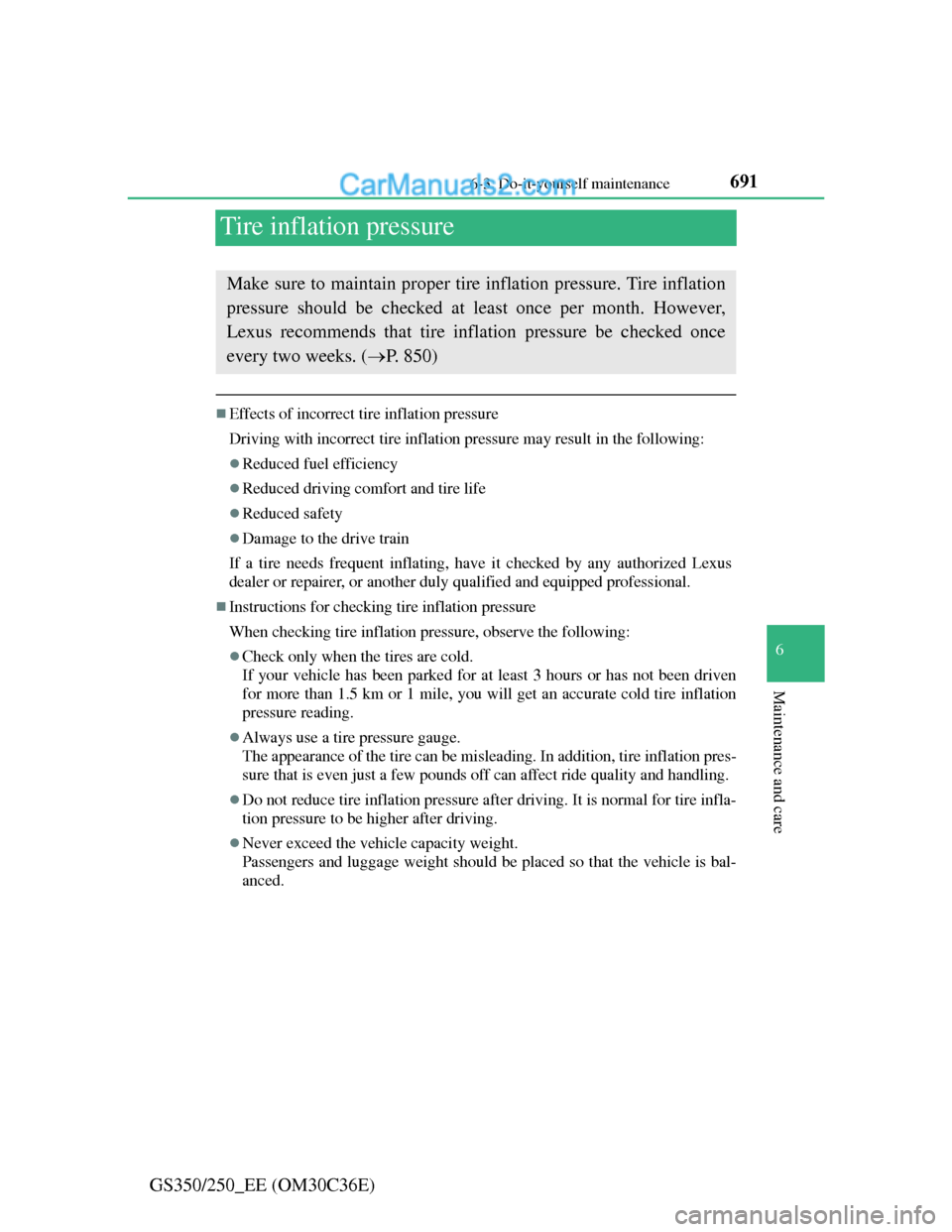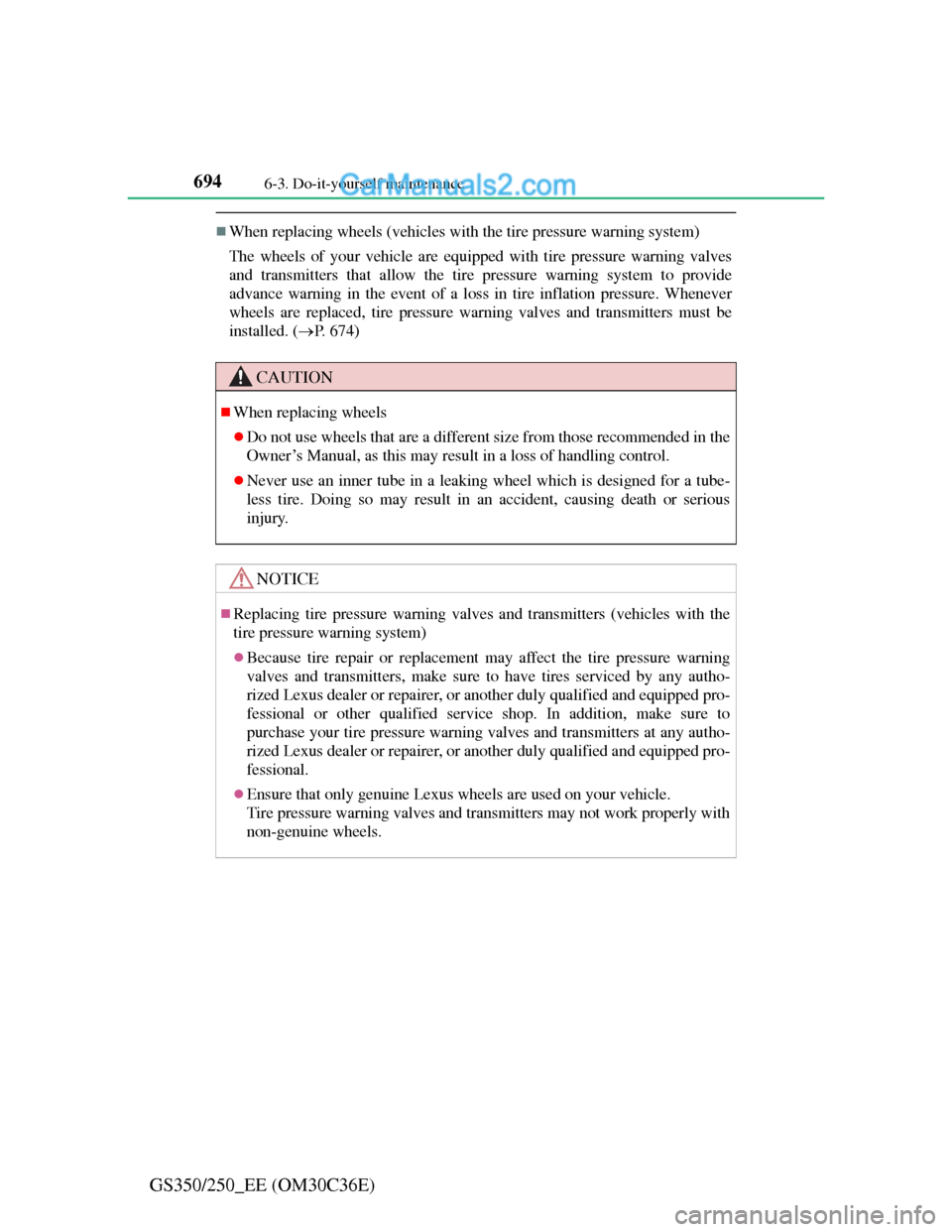Page 708 of 914
6906-3. Do-it-yourself maintenance
GS350/250_EE (OM30C36E)
NOTICE
Driving on rough roads
Take particular care when driving on roads with loose surfaces or potholes.
These conditions may cause losses in tire inflation pressure, reducing the
cushioning ability of the tires. In addition, driving on rough roads may
cause damage to the tires themselves, as well as the vehicle’s wheels and
body.
Low profile tires (except 225/50R17 tires)
Low profile tires may cause greater damage than usual to the tire wheel
when sustaining impact from the road surface. Therefore, pay attention to
the following:
Be sure to use proper tire inflation pressure. If tires are under-inflated,
they may be damaged more severely.
Avoid potholes, uneven pavement, curbs and other road hazards. Failure
to do so may lead to severe tire and wheel damage.
If tire inflation pressure of each tire becomes low while driving
Do not continue driving, or your tires and/or wheels may be ruined.
Page 709 of 914

691
6 6-3. Do-it-yourself maintenance
Maintenance and care
GS350/250_EE (OM30C36E)
Tire inflation pressure
Effects of incorrect tire inflation pressure
Driving with incorrect tire inflation pressure may result in the following:
Reduced fuel efficiency
Reduced driving comfort and tire life
Reduced safety
Damage to the drive train
If a tire needs frequent inflating, have it checked by any authorized Lexus
dealer or repairer, or another duly qualified and equipped professional.
Instructions for checking tire inflation pressure
When checking tire inflation pressure, observe the following:
Check only when the tires are cold.
If your vehicle has been parked for at least 3 hours or has not been driven
for more than 1.5 km or 1 mile, you will get an accurate cold tire inflation
pressure reading.
Always use a tire pressure gauge.
The appearance of the tire can be misleading. In addition, tire inflation pres-
sure that is even just a few pounds off can affect ride quality and handling.
Do not reduce tire inflation pressure after driving. It is normal for tire infla-
tion pressure to be higher after driving.
Never exceed the vehicle capacity weight.
Passengers and luggage weight should be placed so that the vehicle is bal-
anced.
Make sure to maintain proper tire inflation pressure. Tire inflation
pressure should be checked at least once per month. However,
Lexus recommends that tire inflation pressure be checked once
every two weeks. (P. 850)
Page 710 of 914
6926-3. Do-it-yourself maintenance
GS350/250_EE (OM30C36E)
CAUTION
Proper inflation is critical to save tire performance
Keep your tires properly inflated. Otherwise, the following conditions may
occur and result in an accident causing death or serious injury:
Excessive wear
Uneven wear
Poor handling
Possibility of blowouts resulting from overheated tires
Poor sealing of the tire bead
Wheel deformation and/or tire separation
A greater possibility of tire damage from road hazards
NOTICE
When inspecting and adjusting tire inflation pressure
Be sure to put the tire valve caps back on.
Without the valve caps, dirt or moisture could get into the valve and cause
air leakage, which could result in an accident. If the caps are lost, replace
them as soon as possible.
Page 712 of 914

6946-3. Do-it-yourself maintenance
GS350/250_EE (OM30C36E)
When replacing wheels (vehicles with the tire pressure warning system)
The wheels of your vehicle are equipped with tire pressure warning valves
and transmitters that allow the tire pressure warning system to provide
advance warning in the event of a loss in tire inflation pressure. Whenever
wheels are replaced, tire pressure warning valves and transmitters must be
installed. (P. 674)
CAUTION
When replacing wheels
Do not use wheels that are a different size from those recommended in the
Owner’s Manual, as this may result in a loss of handling control.
Never use an inner tube in a leaking wheel which is designed for a tube-
less tire. Doing so may result in an accident, causing death or serious
injury.
NOTICE
Replacing tire pressure warning valves and transmitters (vehicles with the
tire pressure warning system)
Because tire repair or replacement may affect the tire pressure warning
valves and transmitters, make sure to have tires serviced by any autho-
rized Lexus dealer or repairer, or another duly qualified and equipped pro-
fessional or other qualified service shop. In addition, make sure to
purchase your tire pressure warning valves and transmitters at any autho-
rized Lexus dealer or repairer, or another duly qualified and equipped pro-
fessional.
Ensure that only genuine Lexus wheels are used on your vehicle.
Tire pressure warning valves and transmitters may not work properly with
non-genuine wheels.
Page 757 of 914

737
7When trouble arises
GS350/250_EE (OM30C36E)
7-1. Essential information
Emergency flashers ........... 738
If your vehicle
has to be stopped
in an emergency .............. 7397-2. Steps to take in an emergency
If your vehicle needs
to be towed ..................... 740
If you think something
is wrong .......................... 747
Fuel pump shut off system 748
If a warning light turns on or
a warning buzzer sounds 749
If a warning message
is displayed ..................... 757
If you have a flat tire (vehicles
with a spare tire) ............. 782
If you have a flat tire (vehicles
without a spare tire) ........ 797
If the engine will not start . 815
If the shift lever cannot be
shifted from P ................. 817
If the parking brake
cannot be released........... 818
If the electronic key does not
operate properly .............. 821
If the vehicle battery
is discharged ................... 824
If your vehicle overheats .. 829
If the vehicle
becomes stuck................. 832
Page 768 of 914

747
7 7-2. Steps to take in an emergency
When trouble arises
GS350/250_EE (OM30C36E)
If you think something is wrong
Fluid leaks under the vehicle.
(Water dripping from the air conditioning after use is normal.)
Flat-looking tires or uneven tire wear
Engine coolant temperature gauge needle continually points
higher than normal.
Changes in exhaust sound
Excessive tire squeal when cornering
Strange noises related to the suspension system
Pinging or other noises related to the engine
Engine missing, stumbling or running roughly
Appreciable loss of power
Vehicle pulls heavily to one side when braking
Vehicle pulls heavily to one side when driving on a level road
Loss of brake effectiveness, spongy feeling, pedal almost
touches the floor
If you notice any of the following symptoms, your vehicle proba-
bly needs adjustment or repair. Contact any authorized Lexus
dealer or repairer, or another duly qualified and equipped profes-
sional as soon as possible.
Visible symptoms
Audible symptoms
Operational symptoms
Page 774 of 914

7537-2. Steps to take in an emergency
7
When trouble arises
GS350/250_EE (OM30C36E)
*1: Open door warning buzzer:
P. 7 6 3
*2: Driver’s and front passenger’s seat belt buzzer:
The driver’s and front passenger’s seat belt buzzer sounds to alert the
driver and front passenger that his or her seat belt is not fastened. The
buzzer sounds intermittently for 30 seconds after the vehicle reaches a
speed of 20 km/h (12 mph). Then, if the seat belt is still unfastened, the
buzzer will sound in a different tone for 90 more seconds.
Tire pressure warning light
When the light comes on:
Low tire inflation pressure
such as
• Natural causes (P.
754)
• Flat tire (P. 783, 798)
Adjust the tire inflation pres-
sure (including the full-size
spare tire) to the specified
level.
The light will turn off after
a few minutes. In case the
light does not turn off even
if the tire inflation pressure
is adjusted, have the sys-
tem checked by any autho-
rized Lexus dealer or
repairer, or another duly
qualified and equipped
professional.
When the light comes on
after blinking for 1 minute:
Malfunction in the tire pres-
sure warning systemHave the system checked by
any authorized Lexus dealer
or repairer, or another duly
qualified and equipped pro-
fessional.
Wa r n i n g
lightWarning light/DetailsCorrection procedure
Page 775 of 914

7547-2. Steps to take in an emergency
GS350/250_EE (OM30C36E)
Front passenger detection sensor, seat belt reminder and warning buzzer
If luggage is placed on the front passenger seat, the front passenger detec-
tion sensor may cause the warning light to flash and the warning buzzer to
sound even if a passenger is not sitting in the seat.
If a cushion is placed on the seat, the sensor may not detect a passenger, and
the warning light may not operate properly.
If the malfunction indicator lamp comes on while driving
The malfunction indicator lamp will come on if the fuel tank becomes com-
pletely empty. If the fuel tank is empty, refuel the vehicle immediately. The
malfunction indicator lamp will go off after several trips.
If the malfunction indicator lamp does not go off, contact any authorized
Lexus dealer or repairer, or another duly qualified and equipped professional
as soon as possible.
When the tire pressure warning light comes on
Carry out the following procedure after the tire temperature has lowered suf-
ficiently.
Check the tire inflation pressure and adjust to the appropriate level.
If the warning light does not go out even after several minutes, check that
the tire inflation pressure is at the specified level and carry out initialization.
The warning light may come on again if the above operations are conducted
without first allowing the tire temperature to lower sufficiently.
The tire pressure warning light may come on due to natural causes
The tire pressure warning light may come on due to natural causes such as
natural air leaks and tire inflation pressure changes caused by temperature. In
this case, adjusting the tire inflation pressure will turn off the warning light
(after a few minutes).